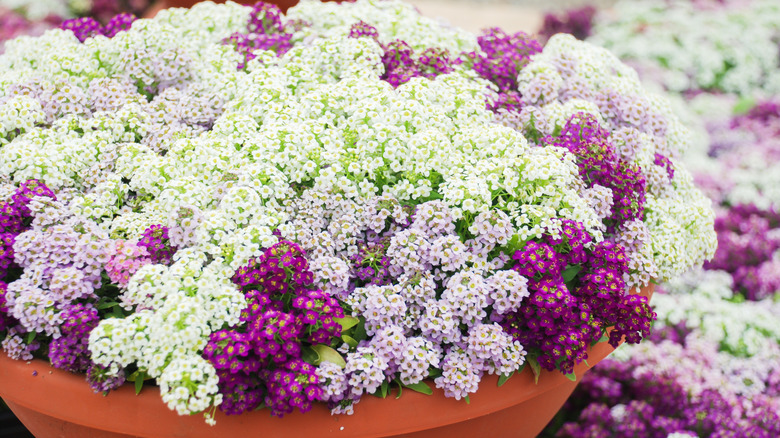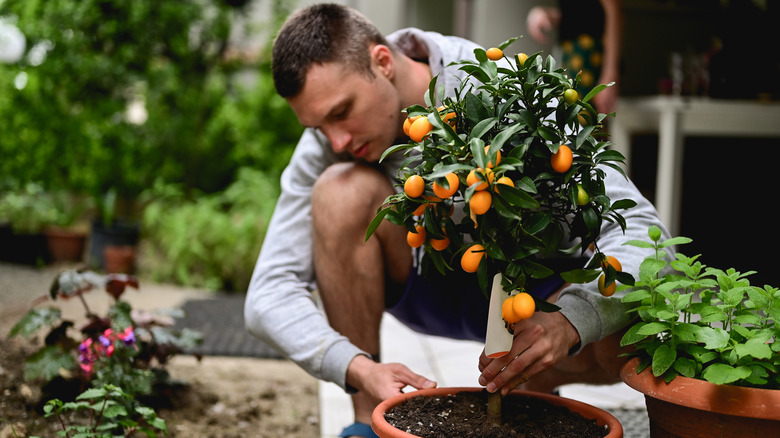Plant This Sweet Flower Under Your Citrus Trees And Say Goodbye To Pests
Between the sweet-smelling blossoms and the delicious fresh fruits, it's no wonder many people love growing citrus trees. As fun and rewarding as it is, it can also set you up for heartbreak if pests and the diseases they carry damage your trees and destroy your fruits. Thankfully, planting sweet alyssum, a dainty and fragrant flower, nearby can go a long way towards protecting your citrus harvest.
The citrus genus is home to beloved grocery store staples including mandarins (C. reticulata), lemons (C. limon), and key limes (C. aurantifolia Swingle), as well as less common species including Buddha's hand (C. medica) and pomelo (C. maxima). Originating from Southeast Asia, most citrus trees are hardy in USDA zones 8-11. Gardeners in cooler regions often grow their citrus trees in containers, making it easy to move them and allow the citrus trees to grow indoors during the winter. While container gardening for trees may seem impractical, it's the best option for growing citrus in colder zones. Regardless of where they are grown, citrus trees thrive in well-draining and mildly acidic soil. While many grow well in part shade, they are most productive in full sun.
Sweet alyssums attract beneficial insects
As beautiful and productive as citrus trees are, they can also be prone to pests including aphids, Asian citrus psyllids (Diaphorina citri), and citrus leafminers (Phyllocnistis citrella). Not only do these insects cause damage to the trees and fruit, but even worse, they can spread diseases like citrus canker and Huanglongbing (sometimes known as citrus greening). In particular, the latter has devastated citrus orchards throughout the world. It's imperative to keep Huanglongbing and the Asian citrus psyllids that carry it away from trees since there's no cure. This is where sweet alyssums come in.
Despite being a petite and often overlooked flower, sweet alyssums (Lobularia maritima) are beloved by beneficial garden insects, including ladybugs, parasitic wasps, and syrphid flies. The larvae of syrphid flies, also called hover flies, regularly eat immature Asian citrus psyllids, ladybugs can make short work of aphids, and parasitic wasp larvae parasitize and consume young leafminers. When you plant sweet alyssums, you welcome some of your best allies in the fight against citrus pests and diseases.
Sweet alyssums are annuals that grow about 12 inches tall and wide, making them perfect flowers for border gardens, containers, and hanging baskets. As they can handle anything from full sun to part shade, alyssums can be easily added to various gardens, though they require well-draining soil.
Combining citrus and sweet alyssum in the garden
As both citrus trees and sweet alyssums thrive in well-draining and slightly acidic soil, they can easily be grown in the same area. While sweet alyssums often make an excellent living mulch, The Old Farmer's Almanac advises against using groundcover plants around citrus trees due to the trees' shallow roots. Instead, plant your sweet alyssums a few feet away if you want to grow them in the ground, or put a pot of them near your citrus tree.
For growers who keep their citrus trees in containers, creating an arrangement of plants of different sizes, each holding a different type of plant, could be the ideal way to combine citrus and alyssums. Planting the citrus tree in a large and tall container, putting alyssums in a smaller pot they can fill up and spill out of, and including a third planter with a medium-sized flowering plant like a rose (Rosa spp.) creates an elegant container garden with plenty of visual interest that also keeps your garden pest free. As alyssums come in several shades of pink, purple, and white, you're sure to find the perfect cultivar to match your garden space.


